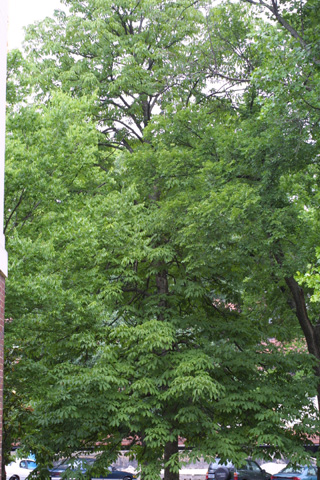 |  |  |  |
An individual instance of Aesculus flava (yellow buckeye)

Permanent unique identifier for this particular organism:
http://bioimages.vanderbilt.edu/vanderbilt/12-53
Notes:
Buckeye leaves are easily recognized because they are palmately compound (leaflets coming from a common point on their petiole or leaf-stalk) and are oppositely arranged on the twig. Two species are found in middle Tennessee -- yellow buckeye (Aesculus flava) and Ohio buckeye (Aesculus glabra) -- although neither species is common. However, yellow buckeye is one of the dominant species in cove forests of the Smoky Mountains. It is virtually impossible to tell these two species apart on the basis of their leaves and bark alone. They are best distinguished by their flowers and fruit. Yellow buckeye flowers are more whitish yellow and have petals with unequal length. Ohio buckeye flowers are more greenish yellow and have petals with equal length. The fruit of buckeyes is unusual. Several shiny, brown nuts (poisonous to humans) are present inside a thin hull that splits into several pieces. The hull of yellow buckeye is smooth, while the hull of Ohio buckeye is spiny.
This tree is described on p. 72 of The Trees of Vanderbilt.
This tree is described on p. 72 of The Trees of Vanderbilt.
 |  |
Load database and switch to thumbnail view
Use this stable URL to link to this page:
http://bioimages.vanderbilt.edu/vanderbilt/12-53.htm
This organism is a living specimen that is part of the Vanderbilt University Arboretum with the local identifier 1-81.
This particular organism is believed to have managedmeans of establishment.
This organismal entity has the scope: multicellular organism.
Remarks:Described in the 1994 Trees of Vanderbilt p. 72.
Identifications:
Aesculus flava
Aiton
sec. Gleason Cronquist 1991
common name: yellow buckeye
family: Hippocastanaceae
Identified 2002-04-10 by Steven J. Baskauf
Location:
Vanderbilt University, Nashville, Davidson County, Tennessee, US
Click on these geocoordinates to load a map showing the location: 36.14172°, -86.79967°
Coordinate uncertainty about: 10 m.
Location of individual determined from GIS database.
Occurrences were recorded for this particular organism on the following dates:
2002-04-10
2002-04-19
2002-04-29
2002-06-11
2002-09-17
2006-05-01
The following images document this particular organism.
Click on a thumbnail to view the image and its metadata.Load database and enable navigation by taxon and organism.








